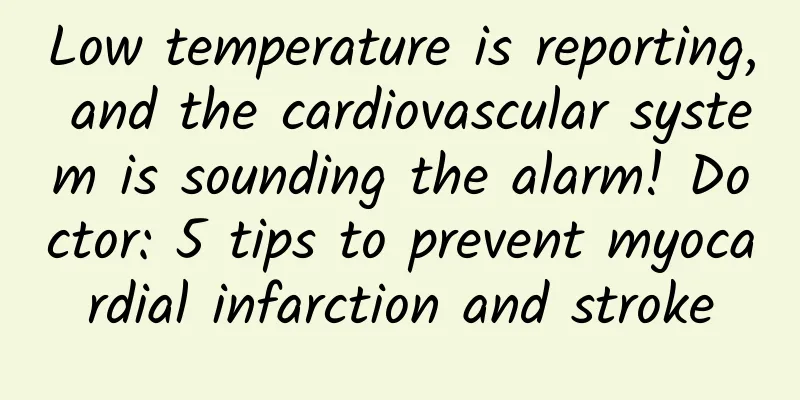Low temperature is reporting, and the cardiovascular system is sounding the alarm! Doctor: 5 tips to prevent myocardial infarction and stroke

|
Low temperature special report, high-risk groups please take note! According to the Central Meteorological Bureau, the first wave of cold air since the beginning of winter this year is arriving this week, accompanied by the strengthening of the northeast monsoon. In addition to the increase in moisture, the most obvious thing is the drop in temperature. When faced with a sudden drop in temperature, the first to be affected are people with three highs, cardiovascular diseases and the elderly, because low temperatures and large temperature differences can easily induce the occurrence of acute cardiovascular diseases, such as myocardial infarction and cerebral stroke. Deputy Director Qian Zhengping of Beitou Health Management Hospital pointed out that in fact myocardial infarction and cerebral stroke can occur throughout the year regardless of the season. However, when it comes to the transition from autumn to winter, the rapid change in temperature can easily cause cardiovascular contraction, leading to unstable blood pressure, which can easily lead to rupture of cerebral blood vessels and cause stroke, or induce diseases such as angina pectoris and myocardial infarction. Therefore, every year when the season reaches the transition from autumn to winter and enters the cold winter, the public is reminded to pay special attention to cardiovascular health. The National Health Administration used data from the "Three Highs" survey from 2005 to 2015, linked it with the National Health Insurance medical data from 2016 to 2017, and analyzed 6,558 cases. It found that the risk of subsequent heart disease in people with the "Three Highs" (high blood pressure, high blood sugar, and high blood lipids) was 1.78 times, 1.47 times, and 1.43 times that of the general population, respectively. The five high-risk groups for cardiovascular disease include: those with three highs, the elderly, obesity, smokers, and those with a family history of cardiovascular disease. Five high-risk groups for cardiovascular disease: the three highs, the elderly, obesity, smoking, and those with a family history of cardiovascular disease In addition to people with the three highs, Dr. Qian Zhengping also added that as the elderly age, their cardiovascular system will gradually lose elasticity, harden, and narrow due to aging, and the chance of subsequent cerebral blood vessel blockage or rupture, leading to a stroke, will also increase. People who are obese, smoke, or have a family history of cardiovascular disease have a higher chance of developing cardiovascular disease than the average person. In the early stages of cardiovascular disease, there will be no symptoms at all. Most of the time, it is a cardiovascular emergency (myocardial infarction and cerebral stroke) that is severe enough to be life-threatening. Most people only realize that their cardiovascular system has become severely hardened and blocked after being rushed to the hospital. At this time, only by seeking medical treatment as soon as possible can the chance of death and disability after survival be reduced. 5 tips to prevent cardiovascular disease: healthy diet, drinking water regularly, regular exercise, staying away from tobacco and alcohol, and regular health check-ups Dr. Qian Zhengping said that in preventing cardiovascular disease, "time" is the most important key. Not only must you rush to the hospital for emergency treatment when an emergency occurs, the best way is to maintain a healthy diet, drink water in moderation, exercise regularly, stay away from tobacco and alcohol, have regular health checks, and do a good job of self-health management in daily life. In particular, regular health checks can help your cardiovascular system maintain a healthy state for a longer period of time. It is recommended that adults should arrange for themselves to measure their blood pressure and have a blood test at least once a year in order to control the three high conditions. It can also be combined with carotid ultrasound examination or further high-level imaging examinations such as cerebrovascular magnetic resonance imaging to observe whether there are vascular lesions. Coronary artery calcification analysis (CAC) can also be used to confirm the calcification of the coronary arteries; coronary artery computed tomography (CTA) can help detect whether the coronary arteries are blocked. |
Recommend
Gynecological diseases are likely to cause irregular menstruation
Irregular menstruation is mainly manifested as ab...
Basketball for fried chicken! Fat boy reduced his BMI in half a year
How to help fat kids lose weight during summer va...
Chinese Herbal Medicine for Chocolate Cyst Treatment
According to Chinese medicine, if you want to tre...
Will poor treatment of cervical warts affect a person's life?
Are cervical warts fatal? Many people would say t...
Who should not get the cervical vaccine?
The cervical vaccine that people often talk about...
What causes uterine cysts and what to do
The formation of uterine cysts is usually related...
What are the treatments for ovarian cysts?
It is also very important to choose an effective ...
What are the common diagnostic methods for endometrial tuberculosis?
Experts say that endometrial tuberculosis is a co...
How is the effect of interventional embolization treatment for adenomyosis?
Interventional embolization for adenomyosis is an...
What are the dietary taboos for cervical erosion?
The number of patients with cervical erosion is i...
What are the main symptoms of adenomyosis?
What are the main symptoms of adenomyosis? The ma...
What methods are more effective in treating cervical warts?
As we all know, genital warts can cause great har...
Causes of amenorrhea after postpartum hemorrhage
The main reason for postpartum hemorrhage leading...
A must-have for weight loss! Eat these snacks without getting fat, banana yogurt is the best choice
For many girls, snacks are a big temptation and a...
What are the symptoms of adnexitis?
What are the characteristics of adnexitis symptom...









